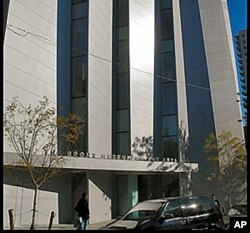The U.S. government has been sending dancers and musicians on international goodwill missions for decades. Now, for the first time, it is sending artists abroad as cultural ambassadors.
The Obama Administration's new cultural diplomacy program is called smART Power. The Bronx Museum of the Arts in New York oversees the initiative.
smART Power
"I think it's fantastic," says Holly Block, the museum's director. "The Bronx Museum itself has done quite a few projects related to community engagement and [having artists] work closely with the community, as well as international artists all over the world. So this fits perfectly. This is the first opportunity I think we've ever had where we're actually able to send U.S.-based artists outside [the U.S.]. Normally we receive artists."
Block says visual artists - including painters, sculptors, architects, designers - may apply for the program starting January 3.
"They will submit their materials with a concept," she explains. "We'll expect them to write a small narrative on what they would like to do. But the idea of this project is really special in the sense that you need to think about community and think about visiting this place and creating a project that's in relationship with maybe some topic that's already going on there, or some of the ideas that you bring to them. We will be working very closely with the artists in selecting partner sites to receive the artists and help them realize their work."
Cultural diplomacy
After 15 artists are selected to participate, they will be sent to work on public art projects with students, teachers, athletes and artists in 15 countries, including Pakistan, Venezuela, China, Nigeria and Lebanon.
"I think it's important for many artists to get out of the bubble of their studio," says Tim Rollins, an artist who is on the Bronx Museum's Board of Directors. Since the 1980s, he has been helping young artists get involved in their communities and visit other cities as well. He believes traveling expands an artist's horizon.
"In every single experience I've ever had, traveling and working abroad, a new concept is created, a new approach becomes possible," Rollins says. "That's often unpredictable. You don't know exactly who you're going to work with, who is going to have an idea that you maybe had never thought of before. When you're together with other communities, it's like a big Thanksgiving Day dinner. The food is really important, but it's often a wonderful experience to get together for an exchange would never have happened."
Rollins expects it will be easy for the smART Power ambassadors to initiate a dialogue with local artists wherever they're sent.
"In my previous experiences - working in all these different places - local artists tend to want to meet you. They want to be involved. They want to know what's going on in the U.S. It's not competitive, it's not spiteful. It's a genuine curiosity. That's one of the most exciting and rewarding aspects of this sort of collaboration is the fact that you meet with many wonderful new people and they are like-minded and creative. And it's all good."
Lasting value
As artist in residence for New York City's Sanitation Department, Mierle Ukeles creates major public artworks that explore the social aspects of waste management - such as putting mirrors on trash trucks to reflect the people who create the trash and choreographing a ballet for trucks at a landfill. She can imagine similar projects in other cities around the world. To succeed though, she says artists need to know more about those foreign communities and have the freedom to express themselves.
"Art is about freedom," she says. "You do whatever you want to. It's always about freedom. Nobody can tell the artist you what to do this or you can do that. Then it's not art. It's something else. I hope that people go with open heart."
Rollins expects they will. While smART Power is funded by the U.S. government, he says artists are the ones who will shape the program.
"Part of the excitement of coming up with projects is to figure out what's going to work," Rollins says. "So it isn't just that the government is sponsoring your vision as an artist in a selfish way. Really it is about what can we do, what can we come up with, which will engage the community that we're going to be visiting? And that's what we are - we are visitors. And, yeah, play the role of being a visitor as opposed to being a tourist, as opposed to being a propaganda instrument for the U.S. That won't work. What will work is a genuine dialogue between the communities to produce something that is of lasting, excellent and cultural value."
And, all those involved hope the smART Power dialogue will also produce something that gives people a better understanding of America and American visual arts.













